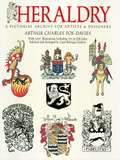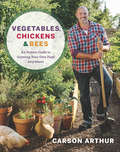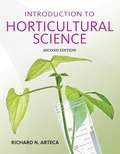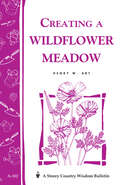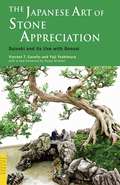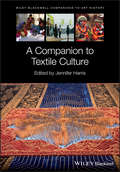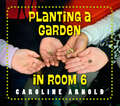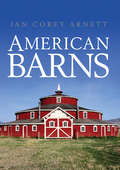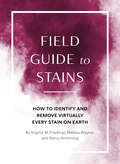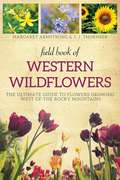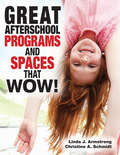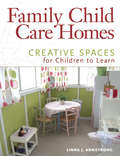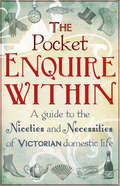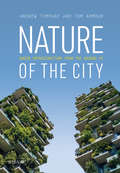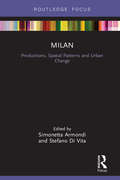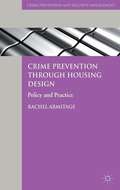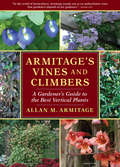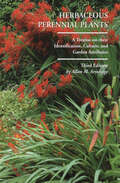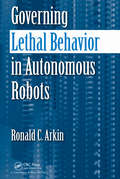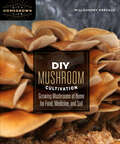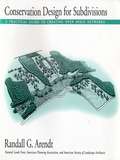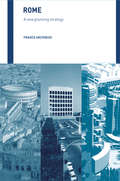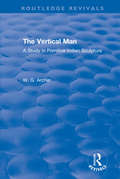- Table View
- List View
Heraldry: A Pictorial Archive for Artists and Designers (Dover Pictorial Archive)
by Arthur Charles Fox-DaviesRoyalty-free treasury of 393 full-color, 654 black-and-white illustrations. Authentic heraldic arms, lions, eagles, dragons, shields, crests, windows, etc. Also, arms of cities and towns, arms of Edward the Black Prince, Milton, Maximilian I, others. Add aristocratic flair, noble bearing to almost any graphic project. Publisher's Note. Captions.
Vegetables, Chickens & Bees: An Honest Guide to Growing Your Own Food Anywhere
by Carson ArthurFor anyone who's ever wanted to grow their own food, comes gardening guru Carson Arthur's honest, and often hilarious, advice for any and every skill level and space.Everyone appreciates the glory of a fresh vine-ripened vegetable, but how do you successfully grow your own? Nobody wants to see their vegetable dreams die the tragic death of a #gardenfail! That is where Carson Arthur comes in, with a wealth of knowledge to guide your gardening decisions and set you up for success in any space. Whether it's a backyard, a rooftop, a balcony or even just a window ledge, this book has everything you need to know about sunlight, space, soil, seeds, and setup. Six years ago, Carson bought a small plot of land two hours outside of the city to try his hand at having his own farm. As a gardener by trade, and with a childhood spent on an apple farm, he had a little experience to back him up! Now he's sharing all of that in Vegetables, Chickens & Bees. Carson provides very real advice on how to choose the right garden for you, how to prepare your dirt and seeds, and gives step-by-step guidance for 20 key veggies you can grow--as well as how to dodge the many pitfalls out there (like checking about the locations of cable wires and gas lines before you start digging up your yard.) Then he shares his favourite recipes for those vegetables so you can have delicious options for everything you grow. Also included are primers on raising your own chickens and keeping your own bees.
Introduction to Horticultural Science (Second Edition)
by Richard N. ArtecaDesigned to provide readers with a full appreciation of the wonderful world of horticultural science, the Second Edition of INTRODUCTION TO HORTICULTURAL SCIENCE covers everything the reader needs to know in a comprehensive format that is easy to understand. Coverage includes critical topics such as fundamental concepts, cutting edge research, careers in horticulture, the relationship between horticulture and the environment, classification of plants, and plant anatomy. Readers are also introduced to key concepts such as plant propagation, media, nutrients and fertilizers, plants and the environment, plant growth regulators, post harvest physiology and pest management, greenhouse structures, nursery site selection, development and facilities, producing nursery crops, and floral design. Through enhanced visual aids and the inclusion of recent trends in the field, the second edition has been designed to peak reader interest and improve reader understanding.
Creating a Wildflower Meadow: Storey's Country Wisdom Bulletin A-102
by Henry W. ArtSince 1973, Storey's Country Wisdom Bulletins have offered practical, hands-on instructions designed to help readers master dozens of country living skills quickly and easily. There are now more than 170 titles in this series, and their remarkable popularity reflects the common desire of country and city dwellers alike to cultivate personal independence in everyday life.
The Japanese Art of Stone Appreciation: Suiseki and its Use with Bonsai (Tuttle Classics)
by Sonja Arntzen Vincent T. Covello Yuji YoshimuraThe Japanese Art of Stone Appreciation is an exploration into the art of suiseki--small, naturally formed stones selected for their shape, balance, simplicity and tranquility.<P><P>Written by two leading experts in the field of Japanese gardening and art, this concise introduction offers aesthetic guidance and direct practical advice that is a window into traditional Japanese culture. It details the essential characteristics of a high-quality suiseki, describing the various systems of stone classification in this Japanese art form and explaining how to display a suiseki to its best advantage. There is also a section on incorporating suiseki alongside a bonsai tree, the most popular and rewarding complement to peaceful suiseki miniature landscape gardens.Sections include:Historical BackgroundCharacteristics and Aesthetic QualitiesClassification of SuisekiDisplaying a StoneSuiseki with Bonsai and Other Related ArtsCollecting SuisekiHow to Make a Carved Wooden BaseSuiseki Classification Systems
A Companion to Textile Culture (Blackwell Companions to Art History)
by Dana ArnoldA lively and innovative collection of new and recent writings on the cultural contexts of textiles The study of textile culture is a dynamic field of scholarship which spans disciplines and crosses traditional academic boundaries. A Companion to Textile Culture is an expertly curated compendium of new scholarship on both the historical and contemporary cultural dimensions of textiles, bringing together the work of an interdisciplinary team of recognized experts in the field. The Companion provides an expansive examination of textiles within the broader area of visual and material culture, and addresses key issues central to the contemporary study of the subject. A wide range of methodological and theoretical approaches to the subject are explored—technological, anthropological, philosophical, and psychoanalytical, amongst others—and developments that have influenced academic writing about textiles over the past decade are discussed in detail. Uniquely, the text embraces archaeological textiles from the first millennium AD as well as contemporary art and performance work that is still ongoing. This authoritative volume: Offers a balanced presentation of writings from academics, artists, and curators Presents writings from disciplines including histories of art and design, world history, anthropology, archaeology, and literary studies Covers an exceptionally broad chronological and geographical range Provides diverse global, transnational, and narrative perspectives Included numerous images throughout the text to illustrate key concepts A Companion to Textile Culture is an essential resource for undergraduate and postgraduate students, instructors, and researchers of textile history, contemporary textiles, art and design, visual and material culture, textile crafts, and museology.
Planting a Garden in Room 6: From Seeds to Salad (Life Cycles in Room 6)
by Caroline ArnoldKindergarteners learn the joys of gardening in this close-up look at how plants grow.A visit to Mrs. Best's classroom is always inspiring! Follow a classroom of real kindergartners as they grow a garden full of healthy vegetables. Joyful photographs show kids planting seeds, tending the seedlings, and harvesting (and eating!) the results. An exciting introduction to the math and science involved in growing a garden. The Life Cycles in Room 6 series follows Mrs. Best&’s real kindergarten class as they help things grow. This photo-illustrated series engages readers with hands-on science in the classroom and beyond.
American Barns
by Jan ArnettThe heart of every working farm and ranch, the barn is an icon of rural America. This book chronicles - and celebrates - all the main types, and looks at how these treasures of early American architecture developed. It explains how a wealth of immigrant construction methods and range of environments and climates resulted in a fascinating variety of barn styles in the United States, from the earliest rare Dutch examples to simpler English types and others in more surprising shapes (round or even polygonal) crafted by the Shakers in the 1800s. It highlights the most notable, famous and historic barns that the reader can visit, and features highlights the efforts of conservation groups to preserve America's barns and find innovative ways to repurpose these glorious old structures as homes and studios--and as living monuments of rural heritage.
Field Guide to Stains: How to Identify and Remove Virtually Every Stain on Earth (Field Guide)
by Nancy Armstrong Melissa Wagner Virginia M. FriedmanAt last, a field guide to identifying and doing battle with more than 100 stains, from tomato juice to tar, from avocado to urine! Field Guide to Stains is divided into handy sections for easy access to information when time is of the essence: Fruits and Vegetables, Meat and Protein, Household Items, Garage and Yard, and more. Readers will learn more than just removal techniques--details include general descriptions and likely seasons, times, and areas of occurrence. Did you know that a yogurt stain is more likely to occur in January (when New Year's resolutions demand more healthy eating), and that correction fluid stains are more prevalent in April (when the pressure to complete your taxes on time is at a high)? Includes more than 100 full-color photographs of stains, each one cross-referenced to its description and step-by-step removal advice. Quick-reference icons guide the reader to the most essential information in each entry. This guide has a sturdy, stain-proof exterior--making it a necessity for every cubicle, glove compartment, and college dorm. Field Guide to Stains is a must-have for everyone about to venture out into the wild, to the kitchen, or to a night on the town!
Field Book of Western Wild Flowers: The Ultimate Guide to Flowers Growing West of the Rocky Mountains
by Margaret ArmstrongMargaret Armstrong, a prolific book cover designer and illustrator, spent a few years traveling around the western United States at the beginning of the twentieth century, and in 1911 she was one of the first women to descend to the floor of the Grand Canyon. There she discovered some new flower species and began writing and illustrating the exquisite and thorough Field Book of Western Wildflowers.This was the first comprehensive handbook to supply detailed information about the plethora of flowers growing in the western United States and includes detailed information on seventy-five plant families, like water-plantain, lily, buttercup, poppy, mustard, hydrangea, plum, rose, cactus, wintergreen, figwort, and valerian families, and many others.Armstrong includes information on key characteristics of each species, including height, leaf and petal features, colors, where each flower can most likely be found, ideal conditions they flourish in, and much more.
Great Afterschool Programs and Spaces That Wow!
by Linda J. Armstrong Christine A SchmidtDoes your afterschool program have the WOW factor?Create a high quality school-age program that is exciting, inviting, and reflects the interests, abilities, and needs of the children. Whether your program operates before or after school, on non-school days, during the summer, or overnight, you can create a dynamic environment where everyone will enjoy spending time.This book is filled with hundreds of ideas-from setting up a quiet reading nook to tackling clutter-reflecting the authors' years of experience and hundreds of visits to a variety of school-age programs. It takes you through all of the considerations that affect your program and then lays out a process to help you improve the three dimensions of a school-age environment.Temporal: Establish schedules, routines, rules, and learning opportunities to meet children's needsInterpersonal: Facilitate the relationships and social interactions of children, staff, families, and the greater communityPhysical: Create sensory-rich indoor and outdoor spacesLinda J. Armstrong and Christine A. Schmidt are experienced educational consultants who serve children and youth programs throughout the United States.
Family Child Care Homes
by Linda J. ArmstrongCreate a warm and inviting place where children feel at home.Discover the many ways your home can provide comfortable places where children love to learn and love to be. Filled with no- and low-cost ideas, this book demonstrates many unique and practical possibilities for your home's indoor and outdoor spaces. Chapters are packed with colorful photographs and provide examples and tips for designing learning zones, selecting items, organizing materials, and more. Checklists, resources, and questions are included to help you evaluate your setting, implement changes, and create a place that feels like a second home to the children in your care.
The Pocket Enquire Within: A guide to the niceties and necessities of Victorian domestic life
by George ArmstrongWhat is the correct way to carve a partridge?How should leeches be applied?How can egg whites be used to repair broken china?First published in 1856, Enquire Within rapidly became the indispensable guide to Victorian domestic life. Packed with words of wisdom and pithy advice, it covered everything from entertaining and etiquette to household management, and took in considered discussion of such arcane matters as how singing might prevent consumption, and which ointments will remove freckles, not to mention why chess should on no account ever be played at a ball.This new, charmingly illustrated pocket-sized edition contains a selection of hints and tips that not only provide a fascinating insight into the day-to-day life of Victorian Britain, but also, in places, reveal timeless wisdom that we would do well to heed today.
Nature of the City: Green Infrastructure from the Ground Up
by Tom Armour Andrew TempanyThis is a practical guide to delivering green infrastructure from the ground up and bringing nature in to the built environment. Exploring the process of delivery through an array of design approaches and case studies, it demystifies the concept and provides the tools for practical implementation - highlighting the challenges and opportunities on both small and large projects.
Milan: Productions, Spatial Patterns and Urban Change (Built Environment City Studies)
by Simonetta Armondi Stefano Di VitaAs a main urban centre of one of the most dynamic European regions, Milan is a key location from which to study narratives of innovations and contemporary productions – old and new manufacturing, tertiary and consumptive sectors, creative and cultural economy – and investigate their influence both on spatial patterns and urban policy agenda. Accordingly, this book explores the contentious geographies of innovation, productions and working spaces, both empirically and theoretically in a city that, since the beginning of the 2000s, has been involved in a process of urban change, with relevant spatial and socio-economic effects, within an increasingly turbulent world economy. Through this analysis, the book provides an insight into the complexity of contemporary urban phenomena beyond a traditional metropolitan lens, highlighting issues such as rescaling, urban decentralization and recentralization, extensive urban transformation and shrinkage and molecular urban regeneration. This book is a valuable resource for academics, researchers and scholars focusing on Urban Studies such as Urban Policy, Urban Planning, Urban Geography, Urban Economy and Urban Sociology.
Crime Prevention through Housing Design
by Rachel ArmitageThis book presents a comprehensive review of the impact of residential design on crime focusing upon research, policy and practice both in the UK and internationally, appealing to both academics and practitioners within the fields of crime prevention, urban planning and architecture.
Armitage's Vines and Climbers: A Gardener's Guide to the Best Vertical Plants
by Allan M. Armitage“Climbing plants are hugely underrated—this book with its lively expression of deep knowledge should encourage everyone to grow more of them.” —Noël Kingsbury Climbing plants constitute a huge, and largely untapped, resource for today’s gardeners. Because their habit of growth is primarily vertical, they can be used for utilitarian as well as ornamental purposes like providing privacy, or screening eyesores. In this comprehensive reference, renowned horticulturist Allan Armitage selects and profiles the most useful and attractive climbing plants for a wide range of sites and conditions, from well-known favourites like clematis, morning glories, and wisteria to more unusual plants like Dutchman’s pipe, passion flowers, and the tropical mandevillas. Each profile includes a general description (enlivened by Armitage’s trademark wry humour) along with the plant’s hardiness, plant family, best method of propagation, method of climbing, and etymology of botanical and common names.“Climbing plants are hugely underrated—this book with its lively expression of deep knowledge should encourage everyone to grow more of them.” —Noël Kingsbury
Herbaceous Perennial Plants: A Treatise on their Identification, Culture, and Garden Attributes
by Allan ArmitageThe third edition of the comprehensive—and entertaining—gardening reference by the master horticulturalist.This is the long-awaited third edition of Allan Armitage’s masterpiece on garden perennials. Armitage’s extensive traveling, teaching, and trialing experiences provide a depth of understanding of the best ornamental perennials for North American gardens unparalleled by any other garden writer. One of the most definitive and conclusive books written about perennials, the first edition was designated as one of the best seventy-five books written in the last seventy-five years by the American Horticulture Society. Now the third edition of “The Big Perennial Book” (as it is fondly referred to by many practitioners) describes 3,600 species in 1224 pages. More than three hundred color photos complement detailed text filled with the author’s pointed observations of plant performance, cultivar selection, and current taxonomy. In addition, his trademark wit and passion are both in abundance, making reading as pleasurable as it is informative.
Governing Lethal Behavior in Autonomous Robots
by Ronald ArkinExpounding on the results of the author's work with the US Army Research Office, DARPA, the Office of Naval Research, and various defense industry contractors, Governing Lethal Behavior in Autonomous Robots explores how to produce an "artificial conscience" in a new class of robots, humane-oids, which are robots that can potentially perform more et
DIY Mushroom Cultivation: Growing Mushrooms at Home for Food, Medicine, and Soil (Homegrown City Life)
by Willoughby Arevalo"Offering clear and comprehensive instructions for low-tech growing for a range of budgets, interests, and scales, this book offers practical inspiration and a sense that "hey, I can do this!" –— DANIELLE STEVENSON, owner, DIY FungiDIY Mushroom Cultivation is full of proven, reliable, low-cost techniques for home-scale cultivation that eliminate the need for a clean-air lab space to grow various mushrooms and their mycelium.Beautiful full-color photos and step-by-step instructions accompany a foundation of mushroom biology and ecology to support a holistic understanding of the practice. Growing techniques are applicable year-round, for any space from house to apartment, and for any climate, budget, or goal. Techniques include:Setting up a home growing spaceInexpensive, simple DIY equipmentCulture creation from mushroom tissue or sporesGrowing and using liquid cultures and grain spawnGrowing mushrooms on waste streams Indoor fruitingOutdoor mushroom gardens and logsHarvesting, processing, tinctures, and cooking.Whether you hunt mushrooms or dream about growing and working with them but feel constrained by a small living space, DIY Mushroom Cultivation is the ideal guide for getting started in the fascinating and delicious world of fungiculture.
Conservation Design for Subdivisions: A Practical Guide To Creating Open Space Networks
by Randall G. ArendtIn most communities, land use regulations are based on a limited model that allows for only one end result: the production of more and more suburbia, composed of endless subdivisions and shopping centers, that ultimately covers every bit of countryside with "improvements." Fortunately, sensible alternatives to this approach do exist, and methods of developing land while at the same time conserving natural areas are available. In Conservation Design for Subdivisions, Randall G. Arendt explores better ways of designing new residential developments than we have typically seen in our communities. He presents a practical handbook for residential developers, site designers, local officials, and landowners that explains how to implement new ideas about land-use planning and environmental protection. Abundantly illustrated with site plans (many of them in color), floor plans, photographs, and renditions of houses and landscapes, it describes a series of simple and straightforward techniques that allows for land-conserving development. The author proposes a step-by-step approach to conserving natural areas by rearranging density on each development parcel as it is being planned so that only half (or less) of the buildable land is turned into houselots and streets. Homes are built in a less land-consumptive manner that allows the balance of property to be permanently protected and added to an interconnected network of green spaces and green corridors. Included in the volume are model zoning and subdivision ordinance provisions that can help citizens and local officials implement these innovative design ideas.
Envisioning Better Communities: Seeing More Options, Making Wiser Choices
by Randall ArendtThe author's work has shaped a generation of planners, designers, and landscape architects. In this book, the author brings his insights to a broader public, with a profusely illustrated demonstration of how local officials, planning commissioners, and everyday citizens can work to make their communities more attractive, more habitable, and more sustainable. Despite the widespread acceptance of good design and planning principles throughout the professions, too many of our towns and rural areas remain needlessly ugly and inefficient. In side by side comparisons of similar places and kinds of buildings, the author shows that we need not live amid sprawling, characterless visual blight. Simple design choices and effective municipal decisions can have tremendous impacts on the quality of our communities. Written in the author's well-known clear, accessible, nontechnical style, this book creates a sense of hope for those who face the everyday challenges of working with developers and landowners to create places that make economic, environmental, and aesthetic sense. The author shows us that with diligence, thoughtfulness, and care, we can make our communities better in countless ways.
Rome: A New Planning Strategy
by Franco ArchibugiRome: A New Planning Strategy looks at the problems of a city over the last century and suggests a totally new planning strategy. The book examines the stages that have marked the increase of population and change in land use and analyses the masterplans used to try and control these evolving conditions. Using Rome as an extended case study, the book deals with the socio-economic effect of an absence of planning strategy during the recent growth of the city. The author presents the characters and features of a new masterplan based on his many years of experience in theoretical and practical planning.
The Vertical Man: A Study in Primitive Indian Sculpture (Routledge Revivals)
by W.G. ArcherOriginally published in 1947, The Vertical Man explores a form of Indian sculpture largely ignored in other studies, with a focus on two kinds of sculpture from the province of Bihar. The book provides detailed analysis of the formal characteristics of the sculpture and the influences of the myth, ritual, and context in which they were commissioned and made. It explains why the sculpture is regional and "why the styles are what they are". It is an original study which throws light on important subjects such as the relations of art and religion and of art and economics. The Vertical Man will appeal to those with an interest in art, specifically sculpture and the art of the Indian countryside.

